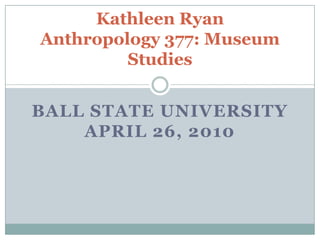
BOOK PRES Kathleen Ryan
- 1. Kathleen RyanAnthropology 377: Museum Studies Ball State UniversityApril 26, 2010
- 2. Conservation and Restoration of Works of Art and Antiquities – Volume 1 Hermann KuhnButterworths1986Page Count: 235
- 3. ThesisPart I: Works of Art and AntiquitiesPart II: EnvironmentPart III: Material ScienceThesis Part I: Works of Art and Antiquities Part II: Environment Part III: Material Science
- 4. Ivory and Bone Objects made of Leather Objects made of Amber Objects made of Wax Objects made of Tortoiseshell and Horn Easel Paintings Wood Sculpture Furniture Prints and Drawings Watercolors Books Papyrus and Inscribed Bark Textiles Part I: Works of Art and Antiquities
- 5. Part 1: Easel Paintings The Support Treatment and restoration of the support
- 6. Part 1: Easel Paintings Canvas Supports
- 7. Part 1: Easel Paintings The Paint Layers and Damage
- 8. Types of Damage and Examination Methods
- 9. Part II: Environment Climatic Conditions Temperature Humidity Light Pollution Atmospheric pollution
- 10. Temperature Humidity As temperature increases, the amount of water vapor needed to saturate the air increases Hygroscopic organic materials absorb and release moisture until equal to that of their environment High temperatures speed up chemical processes of aging Fungi, bacteria and insects favor higher temperatures Sudden or extreme temperature changes can damage works Climatic Conditions
- 11. Part 2: Temperature and Humidity
- 12. Destructive effects of light Ultraviolet Radiation Limitation of lighting Part 2: Light
- 13. Atmospheric pollutants: Cleaning the Air Sulfur dioxide Hydrogen sulfide Ammonia Nitrogen oxides Ozone Carbon monoxide Dust and soot Water sprays Electrostatic precipitators Cyclone precipitators Air intake Recirculation Part 2: Atmospheric Pollution
- 14. Amber Binding Media, Adhesives Ivory, bone, Antler Pigments and Dyes Leather Solvents Paper Papyrus Parchment Pearls, and Beads Tortoiseshell and Horn Soap and Synthetic Detergents Textile Fibers Wax Part III: Material Science
- 15. Binding Media and Adhesives Binding media and adhesives have similar compositions Divided into groups based on: Origin (i.e. animal, vegetable, mineral or synthetic) Composition (oils, resins, proteins etc.,) Whether they are soluble in water or organic solvents How they dry or harden (there are 5 distinctions for this)
- 16. Different Types of Binding Media and Adhesives Oils Natural Resins Wax Synthetic Materials Proteins Plant Gums Starch, Dextrin, Flour
- 17. Professional Use and Others Explains the foundation of terms, methods, materials, scientific examination and other concerns in conservation and restoration. Helps amateurs understanding of treatment and care of works Not “do it yourself” step-by-step information! Warns against untrained alterations of original objects To inform professional conservator on available treatments
- 18. In Conclusion Part I: Works of Art and Antiquities Part II: Environment Part III: Material Science Professional use and use of others Questions?
Editor's Notes
- Page 1
- Page 2
- Preface:The book discusses works of art and artifacts made out of (or mainly from) organic materials. Part 1: Discusses the avoidable damages in each media, mainly those caused by environmental conditions. This section describes the methods of conservation and restoration to educate and familiarize the reader with the technical foundation and other considerations involved in the process. Part 2: Discusses the theoretical foundation to understanding the environmental factors, and advice on how to provide and maintain correct environmental conditions to a work of art or artifact to prevent damage.Part 3: Discusses the preparation, manufacture, properties and behavior of popular materials in art works and also those used in conservation and restoration.
- Page 4
- page
- Page
- Page
- Page:- Aging is caused my exposure to oxygen, humidity and other factors in the environment“The mass of water contained in a given volume of air, measured in grams per cubic meter, is known as absolute humidity.” -137“Relative humidity is the degree of saturation of the air”-p137“ The weight of water vapor needed to saturate a cubic meter of air depends of the air temperature” –p137
- Page
- Page
- Page
- Page
- Page
- Page